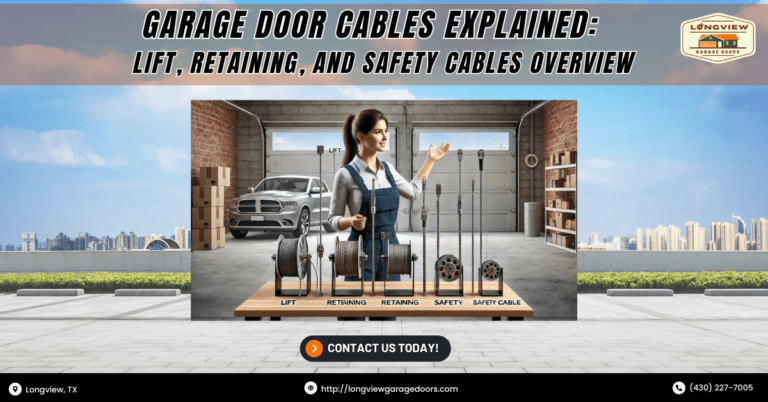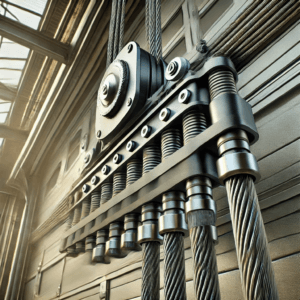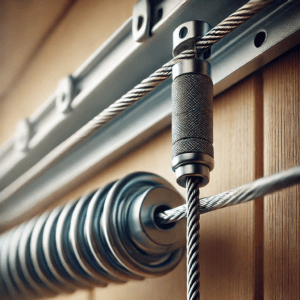Garage Door Cables Explained: Lift, Retaining, and Safety Cables Overview
Learn about garage door cables, including lift, retaining, and safety cables, with Longview Garage Doors in Longview, TX. Keep your garage door safe and reliable in 2024.

When it comes to garage doors, most people think of openers, springs, and tracks—but cables are often overlooked. Yet, these small components play a huge role in keeping your garage door safe and functional. Whether you’re dealing with a garage door repair in Longview, TX, thinking about garage door replacement, or just curious, understanding the different types of garage door cables can help you make better decisions about maintenance and repairs.
In this guide, we’ll break down the three main types of garage door cables—lift, retaining, and safety cables—and explore why they’re essential to the smooth operation of your garage door. Plus, we’ll touch on some key maintenance tips, especially for the unique climate here in Longview, TX.
Why Are Garage Door Cables Important?
Garage door cables are responsible for bearing a significant amount of tension and weight. Without functioning cables, your door could become unbalanced, get stuck, or even fall unexpectedly. Imagine the hassle and potential risks! That’s why understanding these cables and knowing when to replace or repair them can keep you safe and help you avoid a costly emergency garage door repair.
Lift Cables: The Heavy Lifters

What Are Lift Cables?
Lift cables are designed to work with your garage door springs to bear the weight of the door as it opens and closes. Here’s why they’re so important:
- Support for the Door’s Weight: Lift cables bear most of the door’s weight, especially for heavier garage doors. This reduces strain on the springs, which helps prevent premature wear and extends the life of your door system.
- Smooth, Balanced Operation: Without sturdy lift cables, your door would be off-balance and operate unevenly, causing stress on other parts like rollers and hinges.
Signs Your Lift Cables Need Attention
If you notice any of these signs, it may be time for garage door repair in Longview, TX:
- Fraying or Rust: Cables exposed to moisture can rust, which is common in Longview’s humid seasons.
- Unusual Noises: Squeaking, grinding, or clicking sounds may mean cables have started to wear out.
Tip: In Longview, with our mix of dry summers and damp winters, lift cables can wear out more quickly than in other regions, so twice-yearly inspections can help avoid unexpected breaks.
Retaining Cables: Your Backup Safety

Retaining cables are typically found in garage door systems that use extension springs. These cables don’t carry the weight of the door as lift cables do, but they provide an essential safety feature by securing the springs. Here’s why they matter:
- Protection Against Broken Springs: If a spring snaps, retaining cables catch it, preventing it from flying across your garage—a real safety hazard, especially for families with kids or pets.
- Added Security for Older Systems: In older garages, retaining cables act as a preventative safety feature, making them essential for any homeowner who wants to avoid emergency repairs.
When to Check Retaining Cables
In regions like Longview, where garages are subject to fluctuations in humidity and temperature, retaining cables may weaken over time. If you’ve had your garage door for a few years, consider getting an annual inspection from a trusted provider like Longview Garage Doors to avoid surprises.
Safety Cables: The Last Line of Defense

Safety cables are essential to keep your garage door stable if the lift or retaining cables fail. Acting as a “backup,” these cables help maintain door alignment and reduce the risk of accidents.
- Minimizes Risk of Door Collapse: Should other cables fail, safety cables prevent the door from dropping suddenly.
- Important for Older Doors: Safety cables are particularly useful for older doors, which may not have the latest tension-balancing technology.
How to Inspect Safety Cables
Check for rust, fraying, or loose connections, especially if your garage is exposed to Longview’s humid climate. If you see any wear, reach out for emergency garage door repair before it becomes a hazard.
How to Tell When Your Garage Door Cables Need Replacement
If your garage door cables show any of the following issues, it’s probably time for a replacement:
- Visible Fraying or Rust: Frayed or rusty cables are weakened and can snap suddenly, making them a serious risk.
- Loose or Droopy Cables: Drooping or loose cables indicate a loss of tension, which could mean misalignment or other issues with your door.
- Odd Sounds: Squeaks, rattles, or grinding sounds often mean cable tension issues or wear, which can damage other components if not addressed.
Need help determining if it’s time for new cables? At Longview Garage Doors, we’re here to inspect and recommend the right solution for every homeowner in Longview, TX.
FAQs About Garage Door Cables
Q: Can I replace garage door cables myself?
A: Garage door cable replacement can be dangerous due to the high tension in the springs. We strongly recommend leaving this to professionals for a safe and secure installation.
Q: How often should I have my garage door cables inspected?
A: Twice a year is ideal, especially in areas with fluctuating weather like Longview, TX. Routine checks by a professional can prevent unexpected issues.
Q: Are residential and commercial garage door cables different?
A: Yes, commercial cables are often designed for heavier, more frequent use and may require more robust materials. Longview Garage Doors offers tailored services for both residential garage door repair and commercial garage door repair.
Q: What should I check along with the cables?
A: Check springs, rollers, and hinges as these components work together. Well-maintained parts reduce stress on the cables and prevent costly emergency garage door repair needs.
Local Tips for Garage Door Cable Maintenance
Living in Longview means dealing with both dry summer heat and humid winter weather, which can wear down garage door cables. Here are some simple tips:
- Clean and Dry: Wipe down cables and springs regularly to remove dust and moisture.
- Seasonal Inspections: Schedule an inspection with a local pro in spring and fall to get ahead of seasonal wear.
- Lubrication: Keep cables lightly lubricated (ask a professional for guidance on the right product) to protect them from rust.
Following these tips can prevent premature cable wear, helping your door operate smoothly and keeping you safe year-round.
Keep Your Garage Door Safe with Regular Cable Care
Garage door cables may be easy to overlook, but they’re essential for keeping your door safe, balanced, and reliable. By taking care of the lift, retaining, and safety cables and staying on top of regular inspections, you can avoid unexpected issues and the need for emergency garage door repair.
Here in Longview, where garage doors endure hot summers and humid winters, cable maintenance is especially important. If you’re experiencing issues like frayed cables, strange noises, or a door that doesn’t close properly, it may be time to call a professional. At Longview Garage Doors, we provide expert garage door repair in Longview, TX, as well as garage door installation and replacement services for both residential and commercial clients.
So next time you’re driving down Mobberly Avenue or enjoying the sights at the Longview Arboretum, know that Longview Garage Doors has your back. We’re committed to making your garage door safe and dependable, letting you focus on what matters most.
Ready for a safer, smoother garage door? Contact Longview Garage Doors today for reliable, friendly service in Longview, TX. Whether it’s an annual inspection, a quick repair, or a full garage door replacement, we’re here to help! Let’s keep your home secure and your garage door working like new, so you can enjoy all that Longview has to offer with peace of mind.
